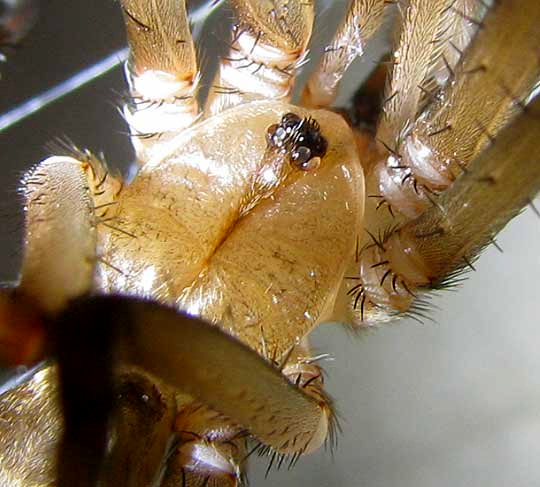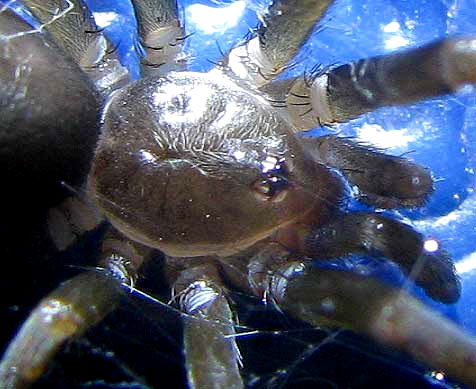Excerpts from Jim Conrad's
Naturalist Newsletter

from the August 5, 2012 Newsletter issued from the woods of the Loess Hill Region a few miles east of Natchez, Mississippi, USA
SOUTHERN HOUSE SPIDER
I write these newsletters in a seldom used storage room. Right above me and to the right, most days I have a companion: A fairly large spider who hangs about his dust-gathering, ceiling-corner cobweb as shown below.

The spider's body itself is about half an inch long (12mm), but from leg tip to leg tip he spans about two inches (5cm). You can see the black-bristled legs and the body's brown color and longish shape at the top of this page. A close-up of the body's front section, the cephalothorax -- illuminated by a high-intensity flashlight -- showing eight beady little black eyes clustered atop it is shown below:

About 3000 spider species are listed for North America (some 35,000 worldwide), so I figured I'd have problems identifying my storage room companion. However, before I began the technical approach I made a wild guess with a search engine: I searched on the keywords "southern house spider."
And, by golly, that's exactly who my friend is: The Southern House Spider, KUKULCANIA HIBERNALIS. Traditionally its technical binomial has been Filistata hibernalis, but genetic sequencing is rearranging spider taxonomy same as it is for plants, birds and insects. Southern House Spiders are distributed from the US's southern tier of states inland as far north as Tennessee, and south through the tropics and subtropics to Argentina and Chile.
Here are the Southern House Spider's main field marks:
The spider in our picture is a male. The female is much darker with a considerably larger body but proportionally much shorter thicker legs. I read that females are seldom seen.
Our spider's genus name, Kukulcania, was bound to arouse my interest, since for the last two and a half years I've lived a brief stroll from the Pyramid of Kukulcan at Chichén Itzá. It happens that the spider expert who created the genus in 1967, Pekka T. Lehtinen, fancied creating names from mythology, so in this instance he chose the Mayas' Kukulcan.
from the August 19, 2012 Newsletter issued from the woods of the Loess Hill Region a few miles east of Natchez, Mississippi, USA
FEMALE SOUTHERN HOUSE SPIDER
Since harmless Southern House Spiders, which we looked at a couple of weeks ago, are somewhat similar to poisonous Brown Recluse Spiders, this week I went looking for Recluses. In another storage building, knowing that Brown Recluses most commonly are found in dark, narrow spaces between and beneath things, I turned over a knee-tall, blue, plastic Coleman cooler, and found what's seen below:

The cottony ball above the spider is the egg bag she is guarding. Notice the juvenile spider below the big spider's abdomen. From leg tip to leg tip is about two inches (5cm). At first I thought I had a Brown Recluse, but the front part, the cephalothorax, lacked the distinct violin-shaped silhouette characteristic of that species. A close-up of this one's cephalothorax is shown below:

It took my heat-dazed mind awhile before it occurred to me that maybe this was a female Southern House Spider. When researching the male we'd learned that in this species females are much stubbier and have relatively shorter, thicker legs than males. On the Internet it was easy to see that this was the case. It's interesting to compare the slender male at the top of our Southern House Spider page with this much heavier female. This species demonstrates tremendous "sexual dimorphism."